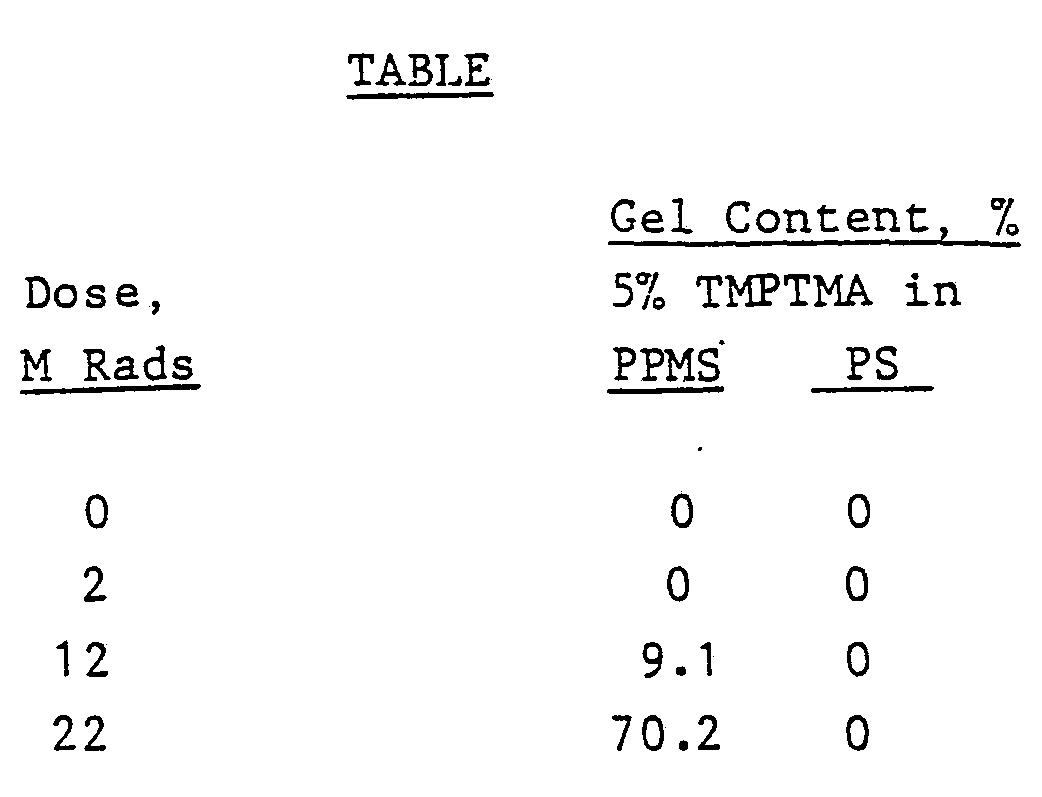[0001] This invention relates blends of poly (p-methylstyrene) with polyfunctional monomers,
which can be crosslinked by ionizing radiation at low dosage levels.
[0002] The present invention provides a blend of pol; (p-methylstyrene) with from 0.1 to
10 weight percent of a polyfunctional monomer.
[0003] The monomer used in preparing the homopolymer or copolymers from which the blends
of this invention are made is p-methylstyrene. It is within the contemplation of this
invention to use mixtures of methylstyrene rich in p-methylstyrene. Such mixtures
contain at least 95 weight percent, preferably 97-99 weight percent, p-methylstyrene
and less than 0.1 weight percent o-methylstyrene with the balance being m-methylstyrene.
A typical mixture contains, by weight, about 95 percent p-methylstyrene, about 5 percent
m-methylstyrene, and about 0.05 percent o-methylstyrene. The mixtures are obtained
by catalytic dehydrogenation of the mixtures of ethylmethyl benzene isomers described
in U.S. Patent No. 4,086,287.
[0004] The polymers contemplated herein are p-methylstyrene or p-methylstyrene-rich isomer
mixture homopolymer or their copolymers containing between about 10 and about 1 weight
percent conjugated diene, such as butadiene and isoprene. The polymerization reaction
is carried out by using methods and catalysts well known in the art for polymerizing
styrene. The reaction can be carried out in solution, bulk, suspension, or emulsion.
[0005] The material that is blended with the poly(p-methylstyrene) is a polyfunctional (polyunsaturated)
monomer. Typical monomers contemplated are divinylbenzene; neopentylglycol diacrylate;
trimethylolpropane triacrylate; trimethylolpropane trimethacrylate; allyl methacrylate;
pentaerythritol triacrylate; pentaerythritol tetramethacrylate; butylene glycol dimethacrylate;
tetraethyleneglycol diacrylate; 1,6-hexanediol dimethacrylate; 1,6-hexanediol diacrylate;
diethyleneglycol diacrylate; diethyleneglycol dimethacrylate; n-hexenyl methacrylate;
polyethyleneglycol dimethacrylate; tetraethyleneglycol dimethacrylate; ethyleneglycol
dimethacrylate; diethylene glycol dimethacrylate; and diallyl fumarate.
[0006] Small amounts of polyfunctional monomers are effective to induce crosslinking by
radiation at low dosage level. Generally, from 0.1 to 10 weight percent, preferably
from 0.5 weight to 5 weight percent, will be used. Blending can be effected in a variety
of ways, such as in solution in aromatic solvents, such as toluene, from which sheets
or films can be cast. The blend components can be mixed in a tumbling agitator and
fed into an extruder to produce sheets, films, or foamed sheets, or they can be fed
separately to an extruder for extruder blending.
[0007] The blends of this invention can be formed into sheets, films, or foamed sheets and
thermoformed to produce shaped articles, such as food containers. After being irradiated,
such shaped articles are heat resistant and are not affected by,fatty foods under
microwave oven conditions.
[0008] Ionizing radiation is inclusive of extremely short-wavelength, high energetic, penetrating
rays such as gamma rays, X-rays, and subatomic particles accelerated in cyclotrons,
betatrons, synchrotrons, and linear accelerators. The effect of irradiating the shaped
articles is to cross-link the poly-(p-methylstyrene) blend. The irradiation dose can
be between about 20 megarads and about 45 megarads, whereas poly(p-methylstyrene)
requires between about 50 megarads and about 60 megarads. Similar blends using polystyrene
are not crosslinked at low dosages.
EXAMPLE
[0009] Poly(p-methylstyrene) (PPMS), containing 3% meta isomer and 0.1% ortho isomer, was
dissolved in toluene at a concentration of 25 weight percent. Then, 5 weight percent
trimethylolpropane trimethacrylate (TMPTMA) based on solids weight was added and dissolved.
Films were cast onto a smooth surface coated with polyethylene terephthalate and drawn
down and dried to obtain a dried film thickness of about 2 mils. Film samples were
irradiated by electron beam at various megarad (M Rads) doses. For each dosage level,
crosslinking was determined by measuring solubility of the irradiated films in toluene
at room temperature overnight. Any insoluble gel thus formed was filtered and dried
to constant weight at 115
0C. For comparison, films of polystyrene (PS) containing 5 weight percent of the TMPTMA
used above were irradiated and tested for gel content. Pertinent data are set forth
in the following Table.

[0010] From the data in the Table, it will be noted that at doses of about 20 M Rads substantial
crosslinking of the blend of PPMS and TMPTMA took place as measured by gelation, whereas.PS
blends did not crosslink. With PPMS alone (unblended), doses in the order of 50-60
M Rads were required. Thus, using the blends of this invention considerable energy
savings are effected.
1. A blend of poly(p-methylstyrene) with from 0.1 to 10 weight percent of a polyfunctional
monomer.
2. The blend of Claim 1 containing from 0.5 to 5 weight percent of the monomer.
3. The blend of Claim 1 or 2, wherein the monomer is divinylbenzene, neopentylglycol
diacrylate, trimethylolpropane triacrylate, trimethylolpropane trimethacrylate, allyl
meuhacrylate, pentaerythritol triacrylate , pentaerythritol tetramethacrylate, butylene
glycol dimethacrylate, tetraethyleneglycol diacrylate, 1,6-hexanediol dimethacrylate,
1,6-hexanediol diacrylate, diethyleneglycol diacrylate, diethyleneglycol dimethacrylate,
n-hexenyl methacrylate, polyethyleneglycol dimethacrylate, tetraethyleneglycol dimethacrylate,
ethyleneglycol dimethacrylate, diethylene glycol dimethacrylate, or diallyl fumarate.
4. The blend of any of Claims 1 to 3, wherein the monomer is trimethylolpropane trimethacrylate.
